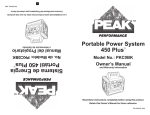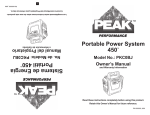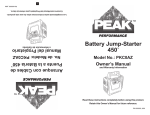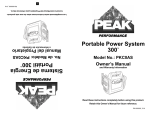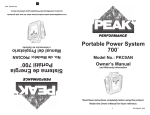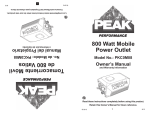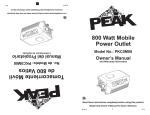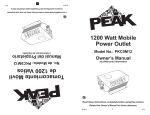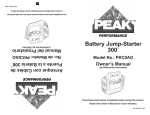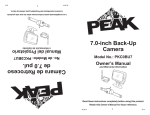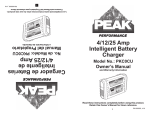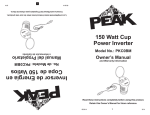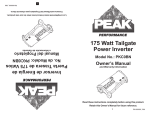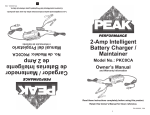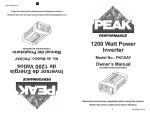Download 750 Peak Amp Power Station Plus
Transcript
© 2013 1 4/13 Retain this Owner’s Manual for future reference. Read these instructions completely before using this product. Manual del Propietario e Información de Garantía 750 Peak Amp Power Station Plus No. de Modelo: PKC0S7 Model No.: PKC0S7 Estación de Energía Plus de Pico a 750 Amps. Owner’s Manual and Warranty Information Lea completamente estas instrucciones antes de usar este producto. Conserve este Manual del Propietario para referencia futura. © 2013 1 4/13 ÍNDICE PRECAUCIONES DE SEGURIDAD............................................................................................................ 2 Seguridad de la Estación de Energía ................................................................................................ 2 Seguridad de la Batería de Arranque con Cables de Puente............................................................ 2 INTRODUCCIÓN......................................................................................................................................... 4 CARACTERÍSTICAS................................................................................................................................... 4 OPERACIÓN............................................................................................................................................... 5 Revisión del Estado de la Batería de la Estación de Energía............................................................ 5 Alerta de Carga Baja (LCA según sus siglas en Inglés).................................................................... 5 Carga de la Batería de la Estación de Energía.................................................................................. 5 Carga de 110/120 Voltios CA.................................................................................................... 5 Arranque con Cables de Puente (Sólo Sistemas de Tierra Negativa)................................................ 6 Operación del Compresor de Aire...................................................................................................... 6 Inflado de Productos con un Vástago de Válvula:..................................................................... 6 Inflado de Productos sin Vástago de Válvula (bolas, colchones de aire, balsas de caucho, etc.):............................................................................................................ 6 Operación del Inversor de Energía CA.............................................................................................. 7 Comprensión de los Artefactos CA........................................................................................... 7 Operación de un Dispositivo CA............................................................................................... 7 Operación de un Enchufe Hembra de Energía CC............................................................................ 7 Operación de un Dispositivo de CC.......................................................................................... 7 Operación del Tomacorriente USB..................................................................................................... 8 Operación de la Luz de Trabajo.......................................................................................................... 8 RESOLUCIÓN DE PROBLEMAS................................................................................................................ 8 CUIDADOS Y MANTENIMIENTO................................................................................................................ 9 Almacenaje........................................................................................................................................ 9 Reemplazo / Descarte de la Batería.................................................................................................. 9 ESPECIFICACIONES.................................................................................................................................. 9 GARANTÍA LIMITADA............................................................................................................................... 10 Para Obtener Servicio...................................................................................................................... 10 PRECAUCIONES DE SEGURIDAD Este símbolo de alerta de seguridad indica que está presente un peligro potencial de lesión personal. Este símbolo es usualmente usado con la palabra de señalamiento (por ejemplo, ADVERTENCIA) la cual designa el grado o nivel de seriedad del peligro. La palabra de señalamiento ADVERTENCIA indica una situación peligrosa que, si no se evita, puede resultar en lesiones serias o en la muerte. La palabra de señalamiento AVISO indica una situación que puede causarle daño al producto, otra propiedad personal y/o al medio ambiente, o causar que el producto funcione de manera incorrecta. La combinación del símbolo de alerta de seguridad y la palabra de señalamiento es usada en mensajes de seguridad a lo largo de este manual y etiquetas de seguridad en este producto. ADVERTENCIA Todos los mensajes de seguridad que siguen tiene niveles de seguridad de ADVERTENCIA. El no cumplirlos puede resultar en lesiones serias o en la muerte. Seguridad de la Estación de Energía • La batería interna en esta Estación de Energía es una batería sellada de plomo-ácido. Siempre use protección para los ojos y tenga precaución cuando trabaje con baterías de plomo-ácido. La batería tiene que ser reciclada o desechada apropiadamente. • Ejecute todos los procedimientos de carga de la Estación de Energía (vea la página 5) en una área bien ventilada, seca y segura, ya que la batería de la unidad produce gases explosivos durante la carga. • La Estación de Energía genera la misma energía, potencialmente mortal, que un tomacorriente doméstico normal de 110/120 voltios CA. No inserte objetos extraños en el tomacorriente de energía CA, en el enchufe hembra CC o en los agujeros de ventilación. • Mantenga esta Estación de Energía lejos del alcance de los niños cuando esté almacenada o en uso. Es necesaria una supervisión cercana cuando se use cerca de los niños. • No use el inversor con dispositivos médicos. • No opere esta Estación de Energía en la lluvia o en la nieve, o sumerja la unidad o los adaptadores en agua o en cualquier otro líquido. • No abra la Estación de Energía. No hay dentro de la unidad piezas reparables por el usuario. Seguridad de la Batería de Arranque con Cables de Puente GASES EXPLOSIVOS — No use este producto en presencia de vapores o gases inflamables. El trabajar cerca de una batería de plomo-ácido puede causar que la batería que se está cargando explote. Cuando las baterías de plomo-ácido están cargando, ellas despiden gas de hidrógeno el cual puede ser encendido por chispas de conexiones eléctricas. Es importante leer este manual antes de cargar una batería y seguir exactamente las instrucciones de arranque con cables de puente (vea la página 5) cada vez que use esta Estación de Energía. 2 EXPLOSIVE GASES — Do not use this product in the presence of flammable fumes or gases. Working in the vicinity of a lead-acid battery can cause an explosion of the battery being charged. When lead-acid batteries are charging, they vent explosive hydrogen gas, which can be ignited by sparks from electrical connections. It is important to read this manual before charging and follow the jump-start instructions exactly (see page 5) each time you use this Power Station. Battery Jump-Starting Safety • The internal battery in this Power Station is a sealed lead-acid battery. Always wear eye protection and exercise caution when working with lead-acid batteries. The battery must be recycled or disposed of properly. • Perform all Power Station charging procedures (see page 5) in a safe, dry, well-ventilated area, as the unit’s battery does produce explosive gases during charging. • The Power Station generates the same potentially lethal 110/120-volt AC power as a normal household wall outlet. Do not insert foreign objects into the AC power outlet, the DC power sockets or the ventilation holes. • Whether stored or in use, keep this Power Station out of the reach of children. Close supervision is necessary when used near children. • Do not use the inverter with medical devices. • Do not operate this Power Station in rain or snow, or immerse the unit or adapters in water or other liquid. • Do not open the Power Station. There are no user-serviceable parts inside the unit. Power Station Safety All safety messages that follow have WARNING level hazards. Failure to comply could result in serious injury or death. This safety alert symbol indicates that a potential personal injury hazard is present. The symbol is usually used with a signal word (e.g., WARNING) which designates the degree or level of hazard seriousness. The signal word WARNING indicates a hazardous situation which, if not avoided, could result in serious injury or death. The signal word NOTICE indicates a situation which can cause damage to the product, other personal property and/or to the environment, or cause the product to operate improperly. The combination of the safety alert symbol and signal word is used in safety messages throughout this manual and on safety labels on this product. SAFETY PRECAUTIONS SAFETY PRECAUTIONS............................................................................................................................ 2 Power Station Safety.......................................................................................................................... 2 Battery Jump-Starting Safety.............................................................................................................. 2 INTRODUCTION......................................................................................................................................... 4 FEATURES.................................................................................................................................................. 4 OPERATION................................................................................................................................................ 5 Checking Power Station Battery Status.............................................................................................. 5 Low Charge Alert (LCA)...................................................................................................................... 5 Charging Power Station Battery.......................................................................................................... 5 110/120-Volt AC Charging......................................................................................................... 5 Jump-Starting (Negative Ground Systems Only)................................................................................ 6 Air Compressor Operation.................................................................................................................. 6 Inflating Products with a Valve Stem:......................................................................................... 6 Inflating Products without a Valve Stem (balls, air mattresses, rubber rafts, etc.):.................... 6 AC Power Inverter Operation.............................................................................................................. 7 Understanding AC Appliances.................................................................................................. 7 Operating an AC Device............................................................................................................ 7 DC Power Socket Operation............................................................................................................... 7 Operating a DC Device.............................................................................................................. 7 USB Power Outlet Operation.............................................................................................................. 8 Worklight Operation............................................................................................................................ 8 TROUBLESHOOTING................................................................................................................................. 8 CARE AND MAINTENANCE....................................................................................................................... 9 Storage............................................................................................................................................... 9 Battery Replacement / Disposal......................................................................................................... 9 SPECIFICATIONS....................................................................................................................................... 9 LIMITED WARRANTY............................................................................................................................... 10 To Obtain Service:............................................................................................................................ 10 CONTENTS 2 3 • Vehicles that have on-board computerized systems may be damaged if vehicle battery is jump-started. Before jump-starting, read the vehicle’s owner’s manual to confirm that external-starting assistance is suitable. • Excessive engine cranking can damage a vehicle’s starter motor. If the engine fails to start after the recommended number of attempts, discontinue these jump-start procedures and look for other problems that may need to be corrected. • This Power Station is not designed to be used as a replacement for a vehicle’s battery. Do not attempt to operate a vehicle that does not have a battery installed. • After connecting the battery charging clamps to the discharged battery and before turning on the jumpstarter ON/OFF switch, check the jump-starter ON indicator on the front of the unit. If the light turns RED and an alarm sounds, the clamp connections are incorrect and need to be reversed. • This Power Station is delivered in a partially charged state. Fully charge unit using the 110/120-volt AC charging plug to the recommended maximum and initial charge time of 36 hours. Thereafter, an AC typical charge time is 18 to 24 hours when using the 110/120-volt AC charging plug. • Although this unit contains a sealed battery, it is recommended that the unit be kept upright during storage, use and recharging. To avoid possible damage that may shorten the unit’s working life, protect it from direct sunlight, direct heat and/or moisture. • Never allow battery acid to come in contact with this unit. • All ON/OFF switches should be in the OFF position when charging the Power Station or when not in use. Make sure all switches are in the OFF position before connecting to a power source or load. • Do not leave the compressor unattended while operating. The compressor is designed for short-term operation only. Operation of the compressor over an extended period of time will cause the compressor unit to overheat and may cause damage. Allow the compressor to cool down for 10 minutes after extended periods of continuous operation. • Do not use any accessory that is not recommended or provided by the manufacturer. All messages that follow have NOTICE level hazards. Failure to comply could result in property damage. Never touch battery clamps together or to a common piece of metal. Sparking, explosion, or damage to the unit can result. Always store the clamps in the appropriate holders on the back of the unit after use. • Place this unit as far away from the battery being charged as the charging cables will permit. • When using the Power Station close to the vehicle’s battery and engine, place the unit on a flat, stable surface, and keep all clamps, cords, clothing and body parts away from moving parts of the vehicle. • Follow these instructions and those published by the battery manufacturer and manufacturer of any equipment you intend to use near the battery. Pay attention to all hazard precautions on these products and on the engine before charging. • This system is designed to be used only on vehicles with a 12-volt DC battery system. Do not connect to a 6-volt or 24-volt battery system. • Remove all jewelry or metal objects that could cause short circuits or react with battery acid. A lead-acid battery produces a short circuit current high enough to weld a ring or other similar objects to metal, causing a severe burn. • When working on electrical equipment, always ensure someone is nearby to help you in an emergency. • Keep a supply of baking soda on hand when working on batteries. Baking soda neutralizes lead-acid battery electrolyte. EYES: SKIN: Wash skin thoroughly if battery acid comes in contact with skin. Seek medical attention immediately. Flush eyes with cool water for at least ten minutes. Seek medical attention immediately. IF INGESTED, CONTACT POISON CONTROL CENTER IMMEDIATELY. FIRST AID • Do not smoke or use flammable items (matches, cigarette lighters, etc.) while working on a vehicle’s battery system. • Never jump-start a frozen battery, as it could explode. • Perform all jump-starting procedures in a safe, dry, well-ventilated area. • Do not expose battery to fire or intense heat since it can explode. • Before recycling or disposing of a battery, protect exposed terminals with heavy-duty electrical tape to prevent shorting (shorting can result in personal injury or fire). • Always wear protective eyewear when using this product. Contact with battery acid can cause blindness and/or severe chemical burns. • Follow these first aid procedures in case of accidental contact with battery acid. • No fume o use artículos inflamables (fósforos, encendedores de cigarrillos, etc.) mientras trabaja en el sistema de batería de un vehículo. • Nunca arranque con cables de puente una batería congelada, ya que puede explotar. • Ejecute el procedimiento de arranque con cables de puente en una área bien ventilada, seca y segura. • No exponga la batería al fuego o al calor intenso ya que puede explotar. • Antes de reciclar o desechar la batería, proteja los terminales descubiertos con cinta aislante eléctrica para evitar cortocircuitos (un cortocircuito puede resultar en heridas corporales o en un incendio). • Cuando use este producto, siempre use gafas para proteger los ojos. El contacto con el ácido de la batería podrá causar ceguera y/o quemaduras químicas severas. • Siga estos procedimientos de primeros auxilios en caso de contacto accidental con ácido de batería. PIEL: OJOS: PRIMEROS AUXILIOS Lávese la piel completamente si el ácido de batería entra en contacto con la piel. Obtenga inmediatamente atención médica. Enjuáguese los ojos con agua fría durante por lo menos diez minutos. Obtenga inmediatamente atención médica. SI SE INGIERE, PÓNGASE INMEDIATAMENTE EN CONTACTO CON UN CENTRO DE CONTROL DE ENVENENAMIENTO. Nunca toque las pinzas de la batería entre sí o contra un pedazo de metal común. Podrá resultar en chispas, explosión o daños a la unidad. Después de usarlas, siempre almacene las pinzas en el porta pinzas apropiado ubicado en la parte trasera de la unidad. • Coloque esta unidad tan lejos de la batería que se está cargando como lo permitan los cables de carga. • Cuando use la Estación de Energía cerca de la batería y del motor del vehículo, coloque la unidad sobre una superficie plana y estable, mantenga todas las pinzas, cordones, ropa y partes del cuerpo alejados de las piezas en movimiento del vehículo. • Siga estas instrucciones y aquellas publicadas por el fabricante de la batería y por el fabricante de cualquier equipo que usted intente usar cerca de la batería. Antes de cargar, préstele atención a las precauciones de peligro en estos productos y en el motor. • Este sistema fue diseñado para ser usado sólo en vehículos con sistema de batería de 12 voltios CC. No lo conecte a un sistema de batería de 6 ó 24 voltios. • Quítese todas las joyas y objetos metálicos que pudieran causar cortocircuitos o reaccionar con el ácido de la batería. Una batería de plomo-ácido produce una corriente de cortocircuito suficientemente alta como para soldar un anillo u otro objeto similar al metal, causando una quemadura severa. • Cuando trabaje en equipos eléctricos, siempre tenga a alguien cerca para que lo ayude en caso de una emergencia. • Mantenga a mano una buena cantidad de carbonato de sodio (baking soda) cuando trabaje con baterías. El carbonato de sodio neutraliza el electrolito de las baterías de plomo-ácido. AVISO Todos los mensajes que siguen tiene niveles de peligro de AVISO. El no cumplir puede resultar en daños a la propiedad. • Los vehículos que tiene sistemas computarizados a bordo pueden sufrir daños si la batería del vehículo es arrancada con cables de puente. Antes de arrancar con cables de puente, lea el manual del propietario del vehículo para confirmar si la asistencia de arranque externa es apropiada. • El darle arranque excesivamente al motor puede dañar el motor de arranque. Si el motor falla en arrancar después de el número recomendado de intentos, descontinúe el procedimiento de arranque con cables de puente y busque otros problemas que necesiten ser corregidos. • Esta Estación de Energía no fue diseñada para que se use como reemplazo de la batería del vehículo. No intente operar un vehículo que no tenga una batería instalada. • Después de conectar las pinzas de carga de batería en la batería descargada y antes de encender el interruptor de ON/OFF de arranque con cables de puente, verifique si el indicador ubicado en el frente de la unidad está en ON. Si la luz se enciende en ROJO y la alarma suena, las conexiones de las pinzas están incorrectas y necesitan ser invertidas. • Esta Estación de Energía se entrega en un estado de carga parcial. Cargue completamente la unidad usando el enchufe de carga de 110/120 voltios CA al máximo recomendado y al tiempo de carga inicial de 36 horas. En lo sucesivo, un tiempo de carga CA típico es de 18 a 24 horas cuando se usa el enchufe de carga de 110/120 voltios CA. • Aunque esta unidad contiene una batería sellada, se recomienda que la unidad sea mantenida de pie durante su almacenaje, uso y recarga. Para evitar posibles daños que le pueden acortar la vida de trabajo a la unidad, protéjala de la luz solar directa, calor directo y/o humedad. • Nunca permita que el ácido de batería entre en contacto con esta unidad. • Todos los interruptores de ON/OFF deben estar en la posición OFF cuando la Estación de Energía esté siendo cargada o no esté siendo usada. Asegúrese de que todos los interruptores estén en la posición OFF antes de conectar la unidad a una fuente de energía o carga. • No deje el compresor desatendido mientras está operando. El compresor fue diseñado sólo para operación de corto tiempo. La operación del compresor durante un período de tiempo extenso causará que la unidad del compresor se recaliente pudiendo causar daños. Deje que el compresor se enfríe durante 10 minutos después de operarlo continuamente por un período extenso. • No use ningún accesorio que no sea recomendado o suministrado por el fabricante. 3 INTRODUCCIÓN CARACTERÍSTICAS • Arranque con cables de puente a la batería integrado de pico a 750 amp. con almacenaje rápido de cables y pinzas • Compresor integrado de 100 lbs./pul.² (7 bar) y manguera de almacenaje rápido para inflar las llantas del vehículo y los equipos de esparcimiento deportivo • Inversor integrado de 100 vatios de potencia (200 vatios pico) para suministrarle energía a electrodomésticos de CA Salida integrada de 110/120 voltios CA Enchufe hembra doble integrado de 12 voltios CC para suministrarle energía a electrodomésticos de CC Tomacorriente USB integrado Luz de trabajo integrada Pantalla/PSI indicadora de nivel de batería Incluye batería sellada, libre de mantenimiento, para trabajo pesado, de plomo-ácido No necesita mantenimiento (fuera de cargarla) para operación óptima Enchufe de carga de 110/120 voltios CA integrado (no incluye cordón de extensión) Boquillas para inflado con aire Fácil de usar, transportar y almacenar La carcasa moldeada de alto impacto es fuerte y durable Alerta de Carga Baja (LCA según sus siglas en Inglés) • • • • • • • • • • • • 2 3 4 5 6 7 8 1 14 9 13 12 20 10 11 15 Leyenda 1. Jump-Starter/USB Port ON/OFF Switch 2. Reverse Polarity Indicator LED 3. Jump-Starter/USB Port ON LED 4. Low Charge Alert (LCA) Port 5. Battery/PSI Indicator Display 6. Worklight ON/OFF Switch 7. Display Button 8. 12-volt DC Power Socket 9. Air Inflator ON/OFF Switch 10. USB Port 11. Worklight 12. 110/120-volt AC Outlet 13. 110/120-volt AC Outlet ON/OFF Switch 14. 110/120-volt AC Outlet Indicator LED 15. 110/120-volt AC Charging Plug 16. Red Positive (+) Jumper Cable 17. Black Negative (–) Jumper Cable 18. Air Inflator Hose 19. Air Inflator Hose Clamp 20. Air Inflation Nozzles 21. LCA Pin Storage Port Legend 21 7 1. Interruptor ON/OFF del Puerto USB/ Arranque con Cables de Puente 2. Indicador LED de Polaridad Invertida 3. LED de ON (ENCENDIDO) del Puerto USB/Arranque con Cables de Puente 4. Puerto de Alerta de Carga Baja (LCA) 5. Pantalla/PSI Indicadora de Nivel de Batería 6. Interruptor ON/OFF de la Luz de Trabajo 7. Botón de Pantalla 8. Enchufe Hembra de 12 voltios CC 9. Interruptor de ON/OFF del Inflador de Aire 10. Puerto USB 11. Luz de Trabajo 12. Salida de 110/120 voltios CA 13. Interruptor de Salida ON/OFF de 110/120 voltios CA 14. Luz LED Indicadora de Salida de 110/120 voltios CA 15. Enchufe de Carga de 110/120 voltios CA 16. Cable de Puente Positivo (+) Rojo 17. Cable de Puente Negativo (–) Negro 18. Manguera de Inflado con Aire 19. Abrazadera de Manguera de Inflado con Aire 20. Boquillas para Inflado con Aire 21. Puerto de Almacenaje del Pin LCA 8 6 5 19 15 10 9 4 Esta Estación de Energía ha sido diseñada y fabricada cuidadosamente para proporcionarle una operación confiable. Por favor lea completamente este manual antes de operar su nueva Estación de Energía, ya que contiene la información que usted necesita para familiarizarse con sus características y obtener el rendimiento que le dará satisfacción continua por muchos años. Por favor guarde este manual para referencia futura. 4 16 17 18 19 21 11 20 12 13 14 1 2 3 • Built-in 750 peak amps battery jump-starter with quick storing cables and clamps • Built-in 100 psi (7 bar) air compressor and quick storing hose to inflate vehicle tires and sport leisure equipment • Built-in 100 watt power (200 peak watts) inverter for powering AC appliances • Built-in 110/120-volt AC outlet • Built-in dual 12-volt DC power sockets for powering DC appliances • Built-in USB power outlet • Built-in worklight • Battery/PSI indicator display • Includes sealed, maintenance-free, heavy-duty, lead-acid battery • Requires no maintenance (other than recharging) for optimal operation • Built-in 110/120-volt AC charging plug (does not include extension cord) • Air inflation nozzles • Safe to use, transport and store • Molded high-impact case is tough and durable • Low Charge Alert (LCA) FEATURES 18 This Power Station has been carefully engineered and manufactured to give you dependable operation. Please read this manual thoroughly before operating your new Power Station, as it contains the information you need to become familiar with its features and obtain the performance that will bring you continued enjoyment for many years. Please keep this manual on file for future reference. 17 16 INTRODUCTION 4 5 OPERACIÓN Revisión del Estado de la Batería de la Estación de Energía Oprima y sostenga el botón de estado de la batería, ubicado en la parte frontal de la unidad, para chequear el nivel de carga de la batería de la Estación de Energía. La pantalla indicadora de nivel de batería/PSI mostrará el estado de carga de la batería como un porcentaje de la capacidad total de la batería. EXPLOSION HAZARD Never allow the jump-start cable clamps (red and black) to touch each other or another common metal conductor. This could cause damage to the unit and/or create a sparking/explosion hazard. Always switch off the jump-starter ON/OFF switch and store the jump-start clamps on the appropriate case clamp posts on the back of the unit after use. This Power Station is equipped with a manual jump-starter/USB ON/OFF switch. Before turning this switch on, check the power/polarity indicator after both jump-start cable clamps have been connected. If the light is RED and an alarm sounds, the clamp connections are incorrect and need to be reversed. If the light is GREEN, the clamp connections are correct. When the jump-start cable clamps are connected and the power/polarity indicator is lit green, it is safe to turn the jump-starter ON/OFF switch to ON. Jump-Starting (Negative Ground Systems Only) Do not exceed maximum recommended AC charge of 36 hours. Disconnect any AC or DC appliance from the Power Station outlet and sockets. Turn all ON/OFF switches to the OFF position. Only charge the Power Station using an approved external AC power cord. Flip out the AC charging plug from the back of the Power Station. Connect the extension plug to the AC charging plug. Plug the extension cord into a 110/120-volt AC outlet. The battery/PSI indicator display will gradually increase as the Power Station is charging. 7. When the Power Station is fully charged, the display will read FL. Disconnect the AC extension cord from the 110/120-volt AC outlet, and then disconnect it from the Power Station AC charging plug. 1. 2. 3. 4. 5. 6. 110/120-Volt AC Charging All rechargeable batteries gradually discharge when left idle, and you need to recharge them periodically to maintain maximum battery capacity. The AC charger is built-in and designed to be used with an extension cord. • To ensure safe recharging and maximum battery life, recharge the Power Station only with the built-in plug. • Fully charge unit with the built-in 110/120-volt AC plug to the recommended maximum and initial charge time of 36 hours. Thereafter, an AC typical charge time is 18 to 24 hours when using the built-in plug. • Recharge the unit fully after each use. This will prolong the life of the battery because frequent discharges between recharges will reduce battery life. • Make sure all functions of the Power Station are turned off during recharging. Due to inherent self-discharge, lead acid batteries should be charged at least every 4 months, especially in a warm environment. Leaving a battery in a discharged state, or if not recharged every 4 months, may result in permanent battery damage and poor jump-starting performance. Do not attempt to recharge the Power Station battery if it is frozen. Gradually warm the frozen battery to 0°C (32°F) before recharging. Charging Power Station Battery The alarm will only be turned off permanently if the battery is in a fully charged state, or the pin is inserted in the Low Charge Alert port. There is a storage port on the back of the Power Station for the LCA plug. When the plug is removed from the LCA port, it should be installed in the storage port on the back of the Power Station. On the front of the unit there is a Low Charge Alert port. There is a red plug in this port. With the plug removed, when the battery level drops to LO, an alarm will sound to remind the user to recharge the Power Station. The alarm can be turned off one of three ways: • Placing the pin back into the Low Charge Alert port • Recharging the battery immediately to bring it to the capacity of 10% or more • Pressing the battery/PSI indicator display button. If the alarm is turned off by pressing the battery display button, the alarm will sound automatically again in approximately 1 hour. Low Charge Alert (LCA) Press and hold the battery status button, located on the front of the unit, to check the Power Station battery charge level. The battery/PSI indicator display will indicate battery charge state as a percentage of the full battery capacity. Checking Power Station Battery Status OPERATION Alerta de Carga Baja (LCA según sus siglas en Inglés) En el frente de la unidad hay un puerto de Alerta de Carga Baja. Hay un tapón rojo en este puerto. Con el tapón removido, cuando el nivel de la batería desciende a LO, sonará una alarma para recordarle al usuario que debe recargar la Estación de Energía. La alarma se puede apagar de una de tres maneras: • Colocando de nuevo el pasador en el puerto de Alerta de Carga Baja • Recargar inmediatamente la batería para subirla a una capacidad del 10% o más. • Oprimiendo el botón de la pantalla indicadora de nivel de la batería/PSI. Si la alarma es apagada oprimiendo el botón de la pantalla de la batería, la alarma sonará de nuevo automáticamente en aproximadamente 1 hora. La alarma sólo será apagada permanentemente si la batería está en un estado de carga total o el pasador es insertado en el puerto de Alerta de Carga Baja. Hay un puerto de almacenaje en la parte trasera de la Estación de Energía para el enchufe LCA. Cuando el enchufe es removido del puerto LCA, deberá ser instalado en el puerto de almacenaje ubicado en la parte trasera de la Estación de Energía. Carga de la Batería de la Estación de Energía Todas las baterías recargables se descargan gradualmente cuando se dejan sin usar y usted necesita recargarlas periódicamente para mantener la capacidad máxima de la batería. El cargador CA es integrado y fue diseñado para ser usado con un cable de extensión. • Para garantizar una carga segura y la máxima vida de la batería, sólo recargue la Estación de Energía con el enchufe integrado. • Cargue completamente la unidad con el enchufe integrado de 110/120 voltios CA al máximo recomendado y tiempo de carga inicial de 36 horas. En lo sucesivo, un tiempo de carga CA típico es de 18 a 24 horas cuando se usa el enchufe integrado. • Recargue completamente la unidad después de cada uso. Esta acción prolongará la vida de la batería ya que descargas frecuentes entre cargadas reducirán la vida de la batería. • Asegúrese de que todas las funciones de la Estación de Energía estén apagadas durante la recarga. AVISO Por causa de la auto descarga inherente, las baterías de plomo-ácido se deben cargar cada 4 meses, especialmente en un medio cálido. El dejar la batería descargada o si no se carga cada 4 meses, podrá resultar en daños permanentes a la batería y pobre rendimiento del arranque con cables de puente. AVISO No intente recargar la batería de la Estación de Energía si está congelada. Caliente gradualmente la batería congelada a 0 °C (32 °F) antes de recargarla. Carga de 110/120 voltios CA AVISO No exceda el tiempo de carga máximo recomendado de CA de 36 horas. 1. Desconecte cualquier aparato de CA o CC de los tomacorrientes y enchufes de la Estación de Energía. 2. Ponga todos los interruptores ON/OFF a la posición OFF. 3. Sólo cargue la Estación de Energía usando un cordón de energía externo CA aprobado. 4. Saque el enchufe de carga CA de la parte trasera de la Estación de Energía. 5. Conecte el enchufe de la extensión en el enchufe de carga CA. 6. Enchufe el cable de extensión en un tomacorriente de 110/120 voltios CA. La pantalla indicadora de nivel de batería/PSI aumentará gradualmente a medida que la Estación de Energía esté cargando. 7. Cuando la Estación de Energía esté completamente cargada, la pantalla leerá FL (llena). Desconecte el cable de extensión CA del tomacorriente de 110/120 voltios CA y luego desconéctelo del enchufe de carga CA de la Estación de Energía. Arranque con Cables de Puente (Sólo Sistemas de Tierra Negativa) Esta Estación de Energía está equipada con interruptor manual de ON/OFF para arranque con cables de puente/USB. Antes de encender este interruptor, verifique el indicador de energía/polaridad después de haber conectado ambas pinzas de los cables de arranque con cables de puente. Si la luz es ROJA y la alarma suena, las conexiones de las pinzas están incorrectas y necesitan ser invertidas. Si la luz es VERDE, las conexiones de las pinzas están correctas. Cuando las pinzas de los cables de arranque con cables de puente están conectadas y el indicador de energía/polaridad está en verde, entonces es seguro colocar el interruptor de ON/OFF en la posición ON. ADVERTENCIA PELIGRO DE EXPLOSIÓN Nunca permita que las pinzas de los cables de arranque con cables de puente (roja y negra) se toquen entre si o contra un conductor de metal común. Esto podrá causarle daños a la unidad y/o crear un peligro de chispas/explosión. Después de cada uso, siempre apague el interruptor de ON/ OFF de arranque con cables de puente y guarde las pinzas en los postes apropiados ubicados en la parte trasera de la unidad. 5 ADVERTENCIA PELIGRO DE EXPLOSIÓN Las conexiones de las pinzas de arranque con cables de puente en la baterías del vehículo tienen que ser positivo con positivo (pinza roja al terminal “+” de la batería) y el negativo (pinza negra) al punto de tierra tal como el chasis metálico del vehículo. Una conexión de polaridad inversa (positivo a negativo) podrá causarle daños a la unidad y/o crear peligros de chispas/explosión. 1. Apague la ignición y todos los accesorios del vehículo. 2. Asegúrese de que la Estación de Energía esté completamente cargada y que el interruptor de ON/OFF de arranque con cables de puente/USB esté en la posición OFF. Apague cualquiera otra función de su Estación de Energía. 3. Consulte el manual del propietario del vehículo para obtener el procedimiento apropiado para arrancar con cables de puente. Muchos vehículos recientes tienen una ubicación separada para arranque con cables de puente, alejada de la batería. Siempre use el procedimiento recomendado por el fabricante de su vehículo. 4. Conecte seguramente el cable rojo positivo (+) al terminal (+) de arranque con cables de puente del vehículo. 5. Conecte el cable negativo negro (–) a una pieza metálica del vehículo que no tenga movimiento. No lo conecte al terminal negativo (–) de la batería. Asegúrese de que la luz roja de polaridad inversa no esté encendida. Si está encendida, los cables de Arranque con Cables de Puente no están instalados correctamente. Deténgase inmediatamente y revise sus conexiones. Continúe sólo si el indicador de polaridad verde está encendido. 6. Si el indicador de polaridad verde está encendido, la pantalla indicadora de batería/PSI de la Estación de Energía mostrará el nivel de carga de la batería del Arranque con Cables de Puente. Si no hay indicación en la pantalla, revise sus conexiones. Si la batería del vehículo está completamente descargada, usted no podrá usar la Estación de Energía. Pueda que sea necesario cargar la batería entes de usar el Arranque con Cables de Puente. 7. Después de verificar que las conexiones están correctas, coloque el interruptor de ON/OFF del Arranque con Cables de Puente/USB en la posición ON. Después de que el interruptor de ON/OFF de Arranque con Cables de Puente/USB esté en la posición ON, el indicador de la batería/PSI mostrará una lectura combinada de la capacidad de la batería de la Estación de Energía y la batería del automóvil. Si no hay lectura, o si la lectura del indicador muestra LO, pueda que la batería del automóvil esté muerta y no podrá ser arrancado con cables de puente. Dé arranque al motor con ráfagas de 5 a 6 segundos. 8. AVISO No le dé arranque al motor por más de 6 segundos. El arranque con cables de puente fue diseñado sólo para operación de corto tiempo. El operar el arranque con cables de puente durante más de 6 segundos podrá causarle daños a la unidad. Deje que la Estación de Energía se enfríe durante por lo menos 3 minutos después de cada arranque con cables de puente. 9. Una vez que el motor prenda, GIRE EL INTERRUPTOR DE ON/OFF DE ARRANQUE CON CABLES DE PUENTE A LA POSICIÓN OFF Y DESCONECTE PRIMERO LA PINZA NEGRA NEGATIVA y luego la pinza roja positiva. 10. Después de cada uso, recargue la Estación de Energía tan pronto le sea posible. Operación del Compresor de Aire ADVERTENCIA PELIGRO DE EXPLOSIÓN Este compresor de aire es capaz de inflar hasta una presión de 100 lbs./pul.² (7 bar). Para evitar sobre inflar, siga cuidadosamente las instrucciones en los artículos que está inflando. Nunca exceda las presiones recomendadas. Siempre revise la presión con el manómetro. Nunca deje el compresor desatendido mientras está en uso. Los artículos sobre inflados se pueden reventar y causar heridas graves. ADVERTENCIA PELIGRO DE INCENDIO No opere el compresor continuamente por períodos de tiempo extensos, ya que se puede recalentar e incendiar. Inflado de Productos con un Vástago de Válvula: 1. Revise las especificaciones del fabricante del artículo que se está inflando para obtener la presión de inflado correcta. 2. Remueva la tapa del vástago de la válvula. 3. Empuje el conector de la manguera de inflado en el vástago de la válvula tanto como le sea posible y baje la palanca de traba. 4. Oprima el interruptor de ON/OFF del inflador de aire a la posición ON. 5. Cuando alcance la presión deseada, oprima el interruptor ON/OFF del inflador de aire a la posición OFF, empuje la palanca de traba hacia arriba y remuévala del vástago de la válvula. Reinstale la tapa del vástago de la válvula. Guarde la manguera de inflado en el compartimiento de almacenaje. Después de cada uso, recargue la Estación de Energía tan pronto le sea posible. 6. 7. Inflado de Productos sin Vástago de Válvula (bolas, colchones de aire, balsas de caucho, etc.): 1. Revise las especificaciones del fabricante del artículo que se está inflando para obtener la presión de inflado correcta. 2. Si aplica, remueva el tapón del orificio de inflado del objeto que necesita aire. 3. Inserte la boquilla de inflado apropiada tanto como le sea posible dentro del conector de vástago de la manguera de inflado. Baje la palanca de traba para trabar la boquilla en el conector de vástago. Inserte la boquilla de inflado en el agujero del objeto que necesita aire. 4. 6 1. Check manufacturer’s specification on item to be inflated for correct inflation pressure. 2. If applicable, remove inflation port plug from the object that needs air. 3. Insert appropriate inflation nozzle as far as possible into stem connector on the inflation hose. Push the locking thumb lever to the down position to lock the nozzle in the stem connector. 4. Insert the inflation nozzle into inflation port on the object that needs air. 5. Press the air inflator ON/OFF switch to the ON position. 6. Monitor item being inflated. Small items such as volleyballs, footballs, etc. inflate very rapidly. 7. When desired pressure is reached, press the air inflator ON/OFF switch to the OFF position. Remove inflation nozzle from the inflation port. If applicable, replace inflation port plug. 8. Remove nozzle from stem connector and wrap the inflation hose around the storage hanger. 9. Recharge the Power Station as soon as possible after each use. Inflating Products without a Valve Stem (balls, air mattresses, rubber rafts, etc.): 1. Check manufacturer’s specification on item to be inflated for correct inflation pressure. 2. Remove valve cap cover from valve stem. 3. Push inflation hose stem connector onto valve stem as far as possible and push the locking thumb lever to the down position. 4. Press the air inflator ON/OFF switch to the ON position. 5. When desired pressure is reached, press the air inflator ON/OFF switch to the OFF position, push the locking thumb lever to the up position and remove from valve stem. Replace valve cap on valve stem. 6. Store inflation hose in storage compartment. 7. Recharge the Power Station as soon as possible after each use. Inflating Products with a Valve Stem: EXPLOSION HAZARD This air compressor is capable of inflating up to 100 psi (7 bar) pressure. To avoid over-inflating, carefully follow instructions on articles to be inflated. Never exceed recommended pressures. Always check pressure with the pressure gauge. Never leave the compressor unattended while in use. Over-inflated articles may burst and can cause serious injury. FIRE HAZARD Do not operate air compressor continuously for extended periods of time, as it may overheat and catch fire. Air Compressor Operation Do not crank the engine for more than 6 seconds. The jump-start feature is designed for short-term operation only. Operating the jump-start feature for more than 6 seconds may cause damage to the unit. Allow the Power Station to cool down for at least 3 minutes after each jump-start. 9. Once engine has started, TURN THE JUMP-STARTER ON/OFF SWITCH TO THE OFF POSITION AND DISCONNECT THE BLACK NEGATIVE CLAMP FIRST and then the red positive clamp. 10. Recharge the Power Station as soon as possible after each use. EXPLOSION HAZARD Jump-start cable clamp connections at the vehicle’s battery terminals must be positive to positive (red clamp to battery “+”) and negative (black clamp) to the grounding point such as the metal frame of the vehicle. A reverse polarity connection (positive to negative) may cause damage to the unit and/or create a sparking/explosion hazard. 1. Turn off ignition and all vehicle accessories. 2. Make sure the Power Station is fully charged and jump-starter/USB ON/OFF switch is in the OFF position. Turn any additional functions of your Power Station off. 3. Check your vehicle’s owners manual for proper jump-starting procedure. Many newer vehicles have a separate location for jump-starting, away from the battery. Always use the vehicle manufacturer’s recommended procedure. 4. Securely connect the red positive (+) cable to the vehicle’s positive (+) jumping terminal. 5. Connect the black negative (–) cable to a non-moving metal part on the vehicle. Do not connect to the negative (–) battery terminal. Make sure the red reverse polarity light is not on. If it is on, the jump-start cables are not installed correctly. Immediately stop and recheck your connections. Only continue if the green polarity indicator is lit. 6. If the green polarity indicator is lit, the Power Station battery/PSI indicator display will show the charge level of the battery to be jump-started. If there is no display, recheck your connections. If the battery for the vehicle is completely discharged, you will not be able to use the Power Station. You may be required to charge the battery before jump-starting. 7. After verifying that connections are correct, turn the jump-starter/USB ON/OFF switch to the ON position. After the jump-starter/USB ON/OFF switch is in the ON position, the battery/PSI indicator display will show a reading for the combined battery capacity of the Power Station and the car battery. If there is no reading, or the display reading shows LO, the car battery may be dead and cannot be jump-started. 8. Crank the engine in 5- to 6-second bursts. 6 7 5. 6. 7. 8. 9. Oprima el interruptor de ON/OFF del inflador de aire a la posición ON. Monitoree el ítem que está siendo inflado. Algunos artículos pequeños tales como pelotas de voleibol, fútbol, etc. se inflan bastante rápido. Cuando alcance la presión deseada, oprima el interruptor de ON/OFF del inflador de aire a la posición OFF. Remueva la boquilla de inflar del puerto de inflar. Si aplica, reinstale el tapón del puerto de inflar. Remueva la boquilla del conector de vástago y enrolle la manguera de inflar en el colgador de almacenaje. Después de cada uso, recargue la Estación de Energía tan pronto le sea posible. Operación del Inversor de Energía CA Comprensión de los Artefactos CA 1. Remove the protective cover from the DC power socket. 2. Plug the 12-volt DC appliance into the power socket. 3. Turn the appliance on (if required). If the appliance draws more than 10 amps (or has a short-circuit defect), the internal circuit breaker of the Power Station shuts off the power to the appliance. If this occurs, unplug the appliance. The internal circuit breaker automatically resets after a few seconds. 4. Fully recharge the Power Station as soon as possible after each use. As the DC power socket is internally wired directly to the Power Station’s battery, extended operation of a 12-volt DC appliance may result in excessive battery discharge. Note: At full charge, the Power Station should power a black and white TV or spotlight for 4 hours, a mini cooler for 3 hours, or a portable vacuum cleaner or coffee maker for up to 1 hour. Application times are estimates only. If two DC appliances are being used from this Power Station, the power is being shared between both appliances and will deplete the charge of the unit that much faster. Operating a DC Device This Power Station is equipped with two 12-volt DC power sockets. It can operate 12-volt DC automobile, RV, marine or other portable appliances that draw less than a total of 10 amps from a 12-volt DC power socket or from a vehicle’s cigarette lighter/accessory socket. The 12-volt DC power sockets are unswitched. There is always power to the 12-volt DC power sockets. DC Power Socket Operation If the green light switches to a red color, immediately turn off the device and then turn off the inverter. Refer to the troubleshooting guide in this manual (see page 8). It is possible that the inverter may have been overloaded or the input voltage may be too low. 1. Before connecting a device to the inverter, be sure the AC outlet/ON/OFF switch is in the OFF position. 2. Also make sure that the device is turned off and that the continuous current draw of the device will not exceed a maximum of 100 watts. 3. Remove the AC outlet cap, then connect the device’s electrical plug into the inverter’s AC outlet. 4. Press the AC outlet/ON/OFF switch to the ON position. If the green AC outlet ON indicator light stays on, the system is working properly. Operating an AC Device Some rechargeable devices are equipped with a separate charger that can be connected to the AC outlet. Certain other rechargeable devices are manufactured with built-in chargers (see device’s manual). In this case, these particular devices may cause internal damage to the inverter and should not be used. The temperature of the device has to be monitored for the first 15 minutes of operation. If the temperature of the device becomes abnormally hot, it is an indication that it should not be used with this inverter. Here is a list of a few other appliances that may be damaged if they are connected to this inverter: • Electronics that modulate radio frequency signals on the AC line will not work and may be damaged. • Variable speed controllers found in some fans, power tools, kitchen appliances and other loads may be damaged. • Metal halide arc (MHI) lights can be damaged. Note: If you are unsure about powering any device with the inverter, contact the manufacturer of the device. AC appliances are rated by how much electrical power (in watts) they consume. The Power Station can power most appliances within its continuous power rating of 100 watts. Some appliances may be difficult or impossible to operate from this Power Station. They may have high surge requirements or should not be run on this unit. The wattage rating of AC appliances is the average power used by the appliance. Appliances such as televisions and appliances with motors consume much more power than their average rating when they are first switched on. Although the Power Station can supply momentary surge power up to 200 watts, some appliances may exceed the capabilities of this unit and trigger the safety overload shutdown circuit. The output of the Power Station’s inverter is a modified sine wave. Some equipment, including medical devices, may not operate properly or be damaged by the inverter output in this unit. Understanding AC Appliances AC Power Inverter Operation Los artefactos de CA son clasificados de acuerdo a cuanta energía eléctrica (en vatios) ellos consumen. La Estación de Energía puede energizar la mayoría de los artefactos dentro de su clasificación de energía continua de 100 vatios. Algunos artefactos podrán ser difíciles o imposibles de operar por esta Estación de Energía. Pueda que ellos tengan requisitos de sobre tensión altos o no deben ser operados en esta unidad. La clasificación de vatiaje de los artefactos de CA es la energía promedio usada por el artefacto. Artefactos como televisores y artefactos con motores consumen mucha más energía que su clasificación de energía promedio cuando son encendidos de primera vez. Aunque la Estación de Energía puede proporcionar energía de sobre tensión momentánea de hasta 200 vatios, algunos artefactos podrán sobrepasar las capacidades de esta unidad y disparar el circuito de seguridad de apagado por sobrecarga. AVISO La salida del inversor de la Estación de Energía es una onda senoidal modificada. Algunos equipos, incluyendo dispositivos médicos, pueda que no operen apropiadamente o pueda que sean dañados por la salida del inversor de esta unidad. AVISO Algunos dispositivos recargables son equipados con un cargador separado que puede ser conectado al tomacorriente de CA. Ciertos otros dispositivos recargables son fabricados con cargadores integrados (ver el manual del dispositivo). En este caso, estos dispositivos particulares podrán causar daños internos al inversor y no se deben usar. La temperatura del dispositivo se tiene que monitorear durante los primeros 15 minutos de operación. Si la temperatura del aparato se torna anormalmente caliente, es una indicación de que el aparato no se debe usar con este inversor. Aquí tienes una lista de otros aparatos que se pueden dañar si son conectados a este inversor. • Equipos electrónicos que modulan frecuencias radiales en la línea CA no trabajarán y se pueden dañar. • Controladores de velocidad variable encontrados en algunos ventiladores, herramientas motorizadas, artefactos de cocina y otras cargas se pueden dañar. • Las luces de arco haluro de metal (MHI) se pueden dañar. Nota: Si usted no está seguro de cómo energizar cualquier dispositivo con el inversor, póngase en contacto con el fabricante del dispositivo. Operación de un Dispositivo CA 1. Antes de conectar un dispositivo al inversor, asegúrese de que el interruptor CA del tomacorriente/ON/ OFF esté en la posición OFF. 2. También asegúrese de que el dispositivo esté apagado y que el consumo de corriente continua no exceda el máximo de 100 vatios. 3. Remueva la tapa del tomacorriente CA, luego conecte el enchufe eléctrico del dispositivo en el tomacorriente CA del inversor. Oprima el interruptor CA del tomacorriente/ON/OFF a la posición ON. Si la luz verde del indicador de salida CA ON se mantiene encendida, el sistema está funcionando apropiadamente. 4. AVISO Si la luz verde cambia a rojo, apague inmediatamente el dispositivo y luego apague el inversor. Consulte la guía de diagnóstico de problemas en este manual (vea la página 8). Es posible que el inversor se haya sobrecargado o que el voltaje de entrada fue demasiado bajo. Operación de un Enchufe Hembra de Energía CC Esta Estación de Energía está equipada con dos enchufes hembras de 12 voltios CC. Puede operar artefactos automotrices, RV, marinos u otros artefactos portátiles de 12 voltios CC que tengan un consumo total inferior a 10 amperios, de un enchufe hembra de 12 voltios CC o de un enchufe hembra del encendedor de cigarrillos/accesorios de un vehículo. AVISO Los enchufes hembra de 12 voltios CC no son conectados por medio de un interruptor. Siempre hay energía en los enchufes hembra de 12 voltios CC. Operación de un Dispositivo de CC 1. Remueva la tapa de protección del enchufe hembra de energía de CC. 2. Enchufe el artefacto de 12 voltios CC en el enchufe hembra. 3. Encienda el artefacto (si es necesario). Si el artefacto consume más de 10 amperios (o tiene un defecto de cortocircuito), el disyuntor interno de la Estación de Energía desconecta la energía hacia el artefacto. Si esto ocurre desenchufe el artefacto. El disyuntor interno se reinicializa automáticamente después de algunos segundos. 4. Después de cada uso, recargue completamente la Estación de Energía tan pronto le sea posible. Puesto que el enchufe hembra de energía CC está alambrado interna y directamente a la batería de la Estación de Energía, la operación extensa de un artefacto de 12 voltios CC podrá resultar en descarga excesiva de la batería. 7 Nota: Con carga completa, la Estación de Energía le deberá suministrar energía a un Televisor en blanco y negro o a una lámpara durante 4 horas, a una mini-nevera durante 3 horas o a una aspiradora portátil o cafetera durante 1 hora. Los tiempos son sólo estimados. Si se están usando dos artefactos por medio de esta Estación de Energía, la energía está siendo compartida por los dos artefactos y agotará la carga de la unidad mucho más rápido. Operación del Tomacorriente USB ADVERTENCIA PELIGRO DE INCENDIO Cuando el interruptor de ON/OFF de Arranque con Cables de Puente/USB es encendido, los cables de arranque con cables de puente están activos. Asegúrese de que los cables del arranque con cables de puente sean almacenados apropiadamente en el área de almacenaje designada en la parte trasera del Arranque con Cables de Puente y que no estén tocando ningún objeto de metal cuando use el puerto USB. AVISO El tomacorriente USB no apoya las comunicaciones de datos. El tomacorriente tiene un máximo de 5 voltios/1.000 mA CC de energía para un dispositivo externo USB-energizado. 1. Enchufe el dispositivo energizado por USB dentro del tomacorriente USB. 2. Encienda el interruptor de ON/OFF del arranque con cables de puente/USB. 3. Encienda el aparato. 4. Cuando apague, primero apague el artefacto y luego apague el interruptor de ON/OFF del arranque con cables de puente/USB. Desenchufe el dispositivo energizado USB del tomacorriente USB. 5. Operación de la Luz de Trabajo • Simplemente gire el interruptor de ON/OFF de la luz de trabajo a la posición ON. • Apáguela cuando no esté siendo usada. RESOLUCIÓN DE PROBLEMAS Problema Causa No hay salida de La carga de la Estación energía CA del de Energía está por debajo de 12 voltios inversor Excesivo consumo de corriente del electrodoméstico que se está operando El inversor no ha calentado completamente Energía inadecuada o caída de voltaje excesivas Inversor sobrecargado El artefacto necesita un vatiaje de sobre tensión alto para arrancar Remedio Recargue la Estación de Energía inmediatamente. Reduzca la carga a un máximo de 100 vatios. Apague el artefacto y el inversor. Desconecte el artefacto. Encienda el inversor y déjelo funcionar durante 2 minutos. Apague el inversor y enchufe rápidamente el artefacto en el inversor, asegúrese de que el artefacto esté apagado entes de conectarlo. Prenda el inversor y el artefacto. Revise el voltaje de la Estación de Energía y recárguela si el voltaje baja a menos de 12 voltios. Reduzca la carga a un máximo de 100 vatios. Remedy La luz indicadora de salida CA en ON está apagada o en rojo El artefacto de CA no arranca Do not use Power Station with low-quality audio AC filtering system. Replace audio system with high-quality noise filtering. Reduce load to maximum of 100 watts. Recharge the Power Station immediately. Prenda y apague rápidamente el interruptor de salida CA/ OFF/USB un total de cinco veces para general la energía necesaria para arrancar el artefacto. Si el artefacto no prende o arranca en cinco ciclos, este inversor no trabajará con este artefacto. Coloque el inversor (Estación de Energía) tan lejos cuanto sea posible de la TV, de la antena y del cable coaxial. La estación de TV está fuera de alcance. 8 Turn AC outlet/OFF/USB switch to the right (USB ON) position. Fully recharge Power Station. Reinsert accessory plug into the 12-volt DC power socket. Replace with a new battery. Sound system has weak alternating current shielding Appliance requires a high Quickly toggle the AC outlet/OFF/USB switch a total of five surge wattage to start up times in order to generate the necessary power to start the appliance. If the appliance does not turn on or start up in five cycles, this inverter will not work with this appliance. Picture breaking up Place the inverter (Power Station) as far as possible away (snow) from the TV, antenna and the coaxial cable. TV station is out of range. Cause Interferencia con La imagen se entrecorta la televisión (nieve) Bad accessory plug connection at the 12-volt DC power socket Low battery charge on Power Station AC outlet/OFF/USB switch is off Fully recharge Power Station. Place the inverter (Power Station) as far as possible away from the audio system. Rotate the cable clamps back and forth to make a good connection. Wait 3 to 4 minutes before starting vehicle again. Inadequate power or excessive voltage drop Inverter overloaded Turn off the appliance and inverter. Disconnect appliance. Turn the inverter on and leave running for a minimum of 2 minutes. Turn off inverter and quickly plug in appliance to inverter, making sure appliance is off prior to connection. Turn on the inverter and the appliance. Check Power Station voltage and recharge if voltage drops below 12 volts. Reduce load to a maximum of 100 watts. Power Station charge is below 12 volts Excessive current drawn by appliance being operated Inverter not warmed up completely Interferencia de El sistema de sonido tiene un blindaje de estática/ruido en el sistema de corriente alterna débil audio Problem No use la Estación de Energía con sistemas de filtrado CA de audio de baja calidad. Reemplace el sistema de audio con filtrado de ruido de alta calidad. Coloque el inversor (Estación de Energía) tan lejos cuanto sea posible del sistema de audio. Accessory device connected to 12-volt DC power socket or USB power outlet does not operate Vehicle does not Improper cable clamp start connections Very low vehicle battery charge Low battery charge on Power Station Vehicle battery defective Static/noise interference in audio system Television interference AC appliance will not start AC outlet ON indicator light is off or red No AC inverter power output TROUBLESHOOTING • Simply turn the worklight ON/OFF switch to the ON position. • Turn off when not in use. Worklight Operation FIRE HAZARD When the jump-starter/USB ON/OFF switch is turned on, the jump-start cables are active. Make sure the jump-starter cables and clamps are properly stored in the designated storage area on the back of the Jump-Starter and are not touching any metal objects when using the USB port. The USB power outlet does not support data communication. The outlet has a maximum of 5 volts/1000 mA DC power to an external USB-powered device. 1. Plug the USB-powered device into the USB power outlet. 2. Turn on the jump-starter/USB ON/OFF switch. 3. Switch the device on. 4. When shutting down, turn the power of the device off first, and then turn the jump-starter/USB ON/OFF switch off. 5. Unplug the USB-powered device from the USB power outlet. USB Power Outlet Operation 8 9 El vehículo no arranca No opera el dispositivo accesorio conectado al enchufe hembra de energía de 12 voltios CC o al tomacorriente USB Conexiones inapropiadas de las pinzas de los cables Carga de la batería del vehículo muy baja Baja carga de la batería de la Estación de Energía Batería del vehículo defectuosa Mala conexión del enchufe de accesorios en el enchufe hembra de energía de 12 voltios CC Baja carga de la batería de la Estación de Energía El interruptor del tomacorriente CA/OFF/ USB está apagado Gire las pinzas de los cables para un lado y el otro para hacer un buen contacto. Espere de 3 a 4 minutos antes de arrancar el vehículo de nuevo. Recargue completamente la Estación de Energía. Reemplácela por una batería nueva. Reinserte el enchufe de accesorios en el enchufe hembra de energía de 12 voltios CC. Recargue completamente la Estación de Energía. Mueva el interruptor de salida CA/OFF/USB hacia la posición derecha (USB ON). CUIDADOS Y MANTENIMIENTO Almacenaje Almacene la Estación de Energía a temperatura ambiente. Después de usarlas, asegúrese de que las pinzas estén guardadas en los postes apropiados en el dorso de la unidad. AVISO Por causa de la auto descarga inherente, las baterías de plomo-ácido se deben cargar por lo menos cada 4 meses, especialmente en un medio cálido. El dejar la batería descargada o si no se carga cada 4 meses, podrá resultar en daños permanentes a la batería y pobre rendimiento del arranque con cables de puente. Reemplazo / Descarte de la Batería 1. Built-in Battery: 12-Volt Rechargeable, Lead-Acid, AGM (Absorbed Glass Mat) Battery 2. Compressor: 100 psi (7 bar) Reading Gauge 3. 110/120-volt AC Outlet: 100 Watt (Peak: 200 Watt/0.3 sec.) 4. 12V Power Socket: 12-Volt, 10-Amp Max. 5. USB Power Outlet: 5 Volts/1000mA Max. 6. Worklight: Five non-replaceable LEDs 7. Charging Time: AC Charging – Maximum and Initial Charge Time 36 Hours; Typical Charge Time 18 to 24 Hours SPECIFICATIONS Because the internal battery contains lead, the Power Station should be recycled or safely disposed of at a local recycling center. Examples of places that will accept items like this are: county or municipal recycling drop-off centers, scrap metal dealers and retailers who sell automotive replacement lead-acid starter batteries. La Estación de Energía fue diseñada para proporcionarle años de servicio. Sin embargo, cuando la batería interna llegue al fin de su vida útil de servicio, la Estación de Energía no sirve para nada. La batería interna no fue diseñada para ser reemplazada por el usuario. Puesto que la batería interna contiene plomo, la Estación de Energía se deberá reciclar o descartar seguramente en un centro de reciclaje local. Ejemplos de lugares que acepta artículos como este son: centros de reciclaje del condado o municipales, distribuidores de chatarra y minoristas que venden baterías automotrices de plomo ácido. ESPECIFICACIONES 100 Vatios (Pico: 200 Vatios/0,3 seg.) Salida de 110/120 Voltios CA: 3. Manómetro de Lectura de 100 Lbs./Pul.² (7 bar) Compresor: 2. Batería Integrada: 1. 4. 5. The Power Station is designed to provide years of service. However, when the internal battery reaches the end of its service life, the Power Station itself is no longer of use. The internal battery is not designed to be user replaceable. Batería de 12 Voltios Recargable, Plomo-Ácido, Absorbed Glass Mat (AGM) (Esterilla de fibra de vidrio absorbida) Enchufe Hembra 12 Voltios, 10 Amp. Máx. de Energía de 12V: Tomacorriente USB: 5 Voltios/1.000 mA Máx. Carga CA – Tiempo Máximo y Carga Inicial 36 Horas; Tiempo de Carga Típico 18 a 24 Horas Tiempo de Carga: 7. Cinco LEDs no reemplazables Luz de Trabajo: 6. Battery Replacement / Disposal Due to inherent self-discharge, lead acid batteries should be charged at least every 4 months, especially in a warm environment. Leaving a battery in a discharged state, or if not recharged every 4 months, may result in permanent battery damage and poor jump-starting performance. Store the Power Station at room temperature. Make sure the battery clamps are stored on the appropriate case clamp posts on the back of the unit after use. Storage CARE AND MAINTENANCE 9 GARANTÍA LIMITADA 10 El fabricante le garantiza al consumidor original o comprador, que la Estación de Energía Plus de Pico a 750 amps. PEAK® modelo PKC0S7 estará libre de defectos en material y mano de obra durante un año a partir de la fecha de venta al comprador original. El fabricante por la presente excluye y renuncia a cualquier otra garantía, expresa o implícita, más allá de aquellas garantías especificadas anteriormente. El fabricante excluye cualquier garantía implícita de comerciabilidad o de aptitud para un propósito en particular. SI SU ESTACIÓN DE ENERGÍA PLUS DE PICO A 750 AMPS. PEAK® TIENE UN MAL FUNCIONAMIENTO DEBIDO A UN DEFECTO EN MATERIAL O MANO DE OBRA DENTRO DEL AÑO DEL PERÍODO DE GARANTÍA, EL FABRICANTE A SU ELECCIÓN LA REPARARÁ O CAMBIARÁ. EL FABRICANTE, SIN EMBARGO, NO SERÁ RESPONSABLE POR NINGÚN DAÑO A SU PRODUCTO DEBIDO A CUALQUIER CAUSA QUE NO SE DEBA A DEFECTOS EN MATERIAL O MANO DE OBRA, INCLUYENDO SIN LIMITACIONES: NO SEGUIR LAS INSTRUCCIONES DE USO, MAL USO, REPARACIONES EFECTUADAS POR PERSONAS NO AUTORIZADAS, MAL MANEJO, MODIFICACIONES, DESGASTE NORMAL, ACCIDENTES O SOBRECARGA. LA REPARACIÓN O REEMPLAZO SEGÚN ESTA GARANTÍA ES EL REMEDIO EXCLUSIVO DEL CLIENTE. EL FABRICANTE NO SERÁ RESPONSABLE POR NINGÚN DAÑO INCIDENTAL, CONSECUENTE O PUNITIVO POR QUEBRANTO DE CUALQUIER GARANTÍA EXPRESA O IMPLÍCITA DE ESTE PRODUCTO O BASADO EN CUALQUIERA OTRA CAUSA O RECLAMO. Para Obtener Servicio: 1. Antes de retornar este producto por cualquier razón, por favor llame gratis al teléfono (800) 477-5847. 2. No regrese para servicio su producto PEAK® al lugar de compra. Envíe la unidad, con porte pre pagado y asegurado, junto con una copia del recibo de venta original y un número telefónico a la dirección mostrada a continuación. Empaque la unidad apropiadamente, ya que no somos responsables por ningún daño causado durante el envío. Old World Industries, LLC c/o Technical Services 4065 Commercial Avenue Northbrook, IL 60062 3. Se requiere una copia del recibo original para servicio de garantía. Si no presenta un recibo, la fecha de fabricación será usada como la fecha de compra. PEAK y la gráfica de la Montaña PEAK son marcas registradas de Old World Industries, LLC, Northbrook, IL 60062 Todos los derechos reservados FABRICADO EN CHINA www.peakauto.com PEAK and the PEAK Mountain graphic are trademarks of Old World Industries, LLC, Northbrook, IL 60062 All Rights Reserved MADE IN CHINA www.peakauto.com 3. A copy of the original receipt is required for warranty service. If no receipt is provided, the unit manufacturer’s date will be used as the date of purchase. Old World Industries, LLC c/o Technical Services 4065 Commercial Avenue Northbrook, IL 60062 2. Do not return your PEAK® product to the place of purchase for service. Send your unit, postage prepaid and insured, along with a copy of the original sales receipt and a phone number to the address below. Pack your unit properly, as we are not responsible for any damage caused during shipping. To Obtain Service: 1. Before returning this product for any reason, please call toll free (800) 477-5847. Manufacturer warrants to the original consumer, or purchaser, that the PEAK® 750 Peak Amp Power Station Plus PKC0S7 will be free from defects in material and workmanship for one year from the date of sale to the original purchaser. Manufacturer hereby excludes and disclaims any and all other warranties, expressed or implied, beyond those warranties specified above. Manufacturer excludes any implied warranty of merchantability or fitness for a particular purpose. IF YOUR PEAK® 750 PEAK AMP POWER STATION PLUS MALFUNCTIONS DUE TO A DEFECT IN MATERIALS AND WORKMANSHIP WITHIN THE ONE YEAR WARRANTY PERIOD, MANUFACTURER WILL, AT ITS ELECTION REPAIR OR REPLACE IT. MANUFACTURER SHALL NOT, HOWEVER, BE RESPONSIBLE FOR ANY DAMAGE TO YOUR PRODUCT DUE TO ANY CAUSE OTHER THAN DEFECTS IN MATERIAL OR WORKMANSHIP, INCLUDING WITHOUT LIMITATION: FAILURE TO FOLLOW INSTRUCTIONS FOR USE; MISUSE; REPAIRS BY AN UNAUTHORIZED PERSON; MISHANDLING; MODIFICATIONS; NORMAL WEAR AND TEAR; ACCIDENT OR OVERLOAD. REPAIR OR REPLACEMENT AS PROVIDED UNDER THIS WARRANTY IS THE EXCLUSIVE REMEDY OF THE CONSUMER. MANUFACTURER SHALL NOT BE LIABLE FOR ANY INCIDENTAL, CONSEQUENTIAL OR PUNITIVE DAMAGES FOR BREACH OF ANY EXPRESSED OR IMPLIED WARRANTY ON THIS PRODUCT OR BASED ON ANY OTHER CAUSE OR CLAIM. LIMITED WARRANTY 10











